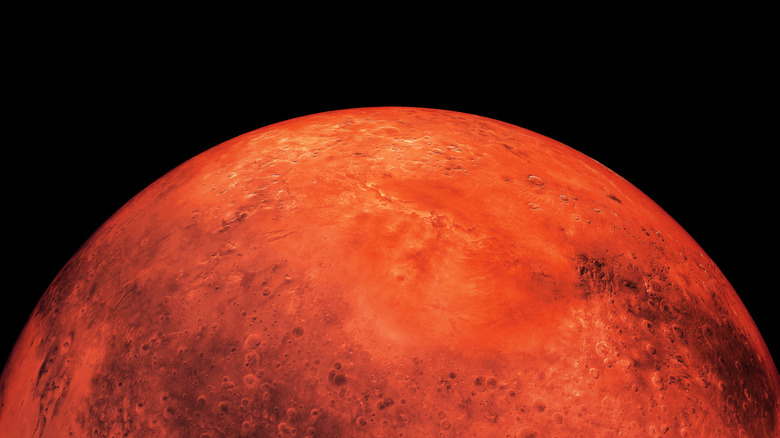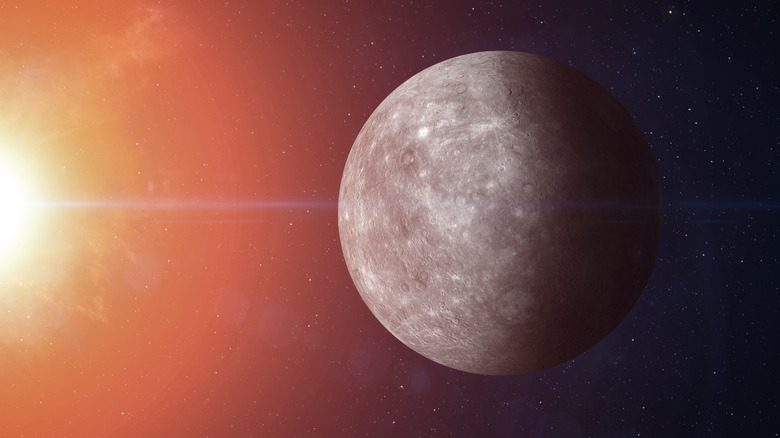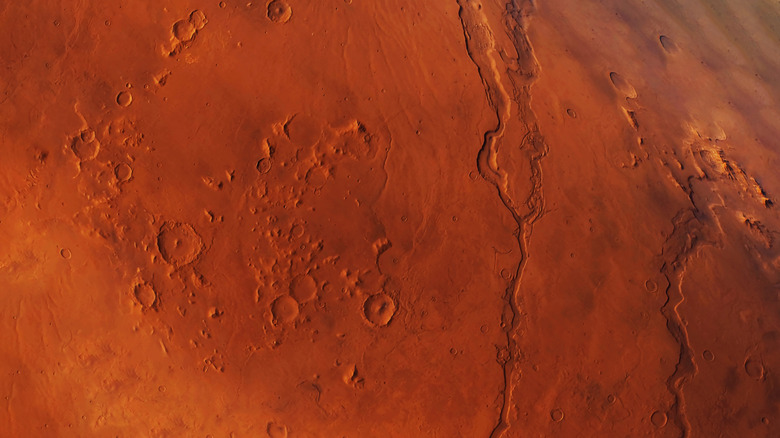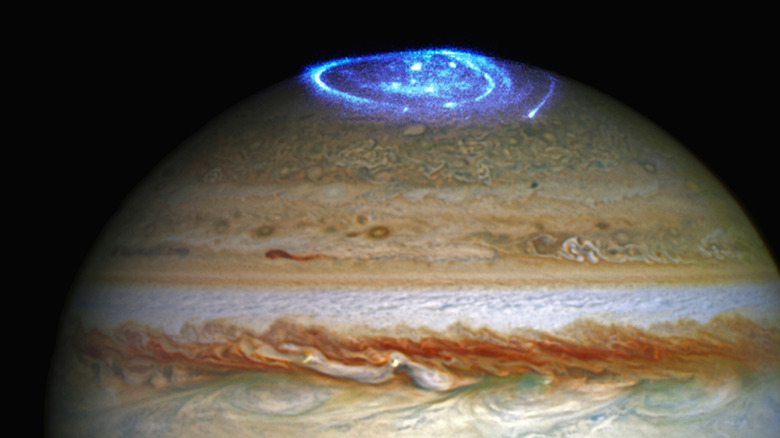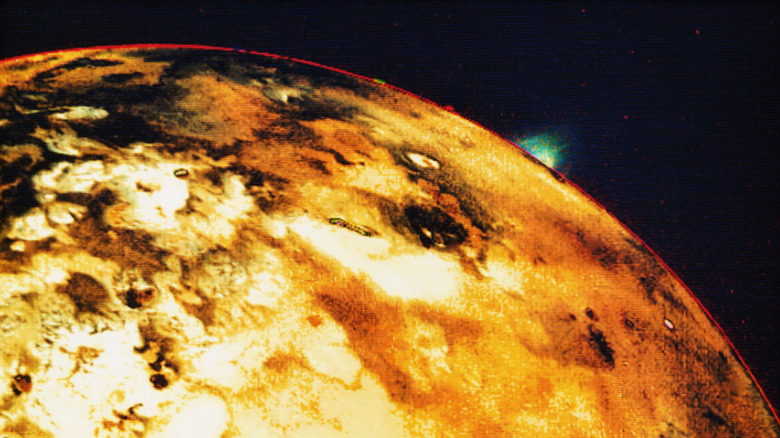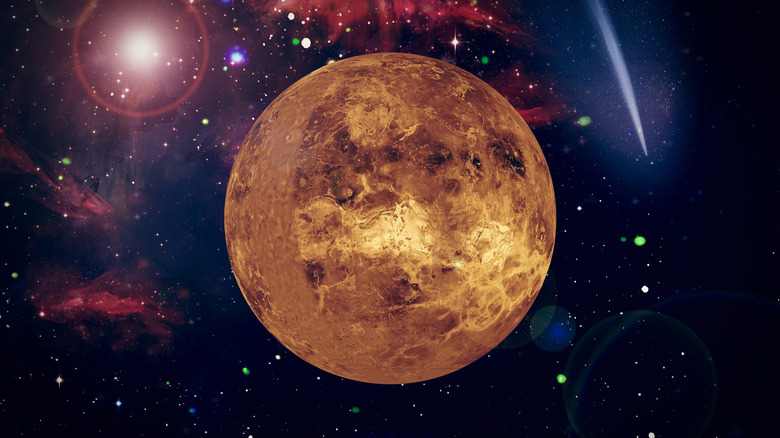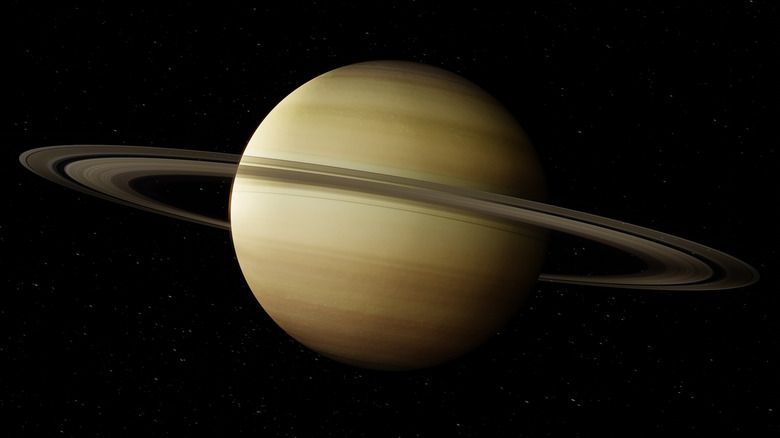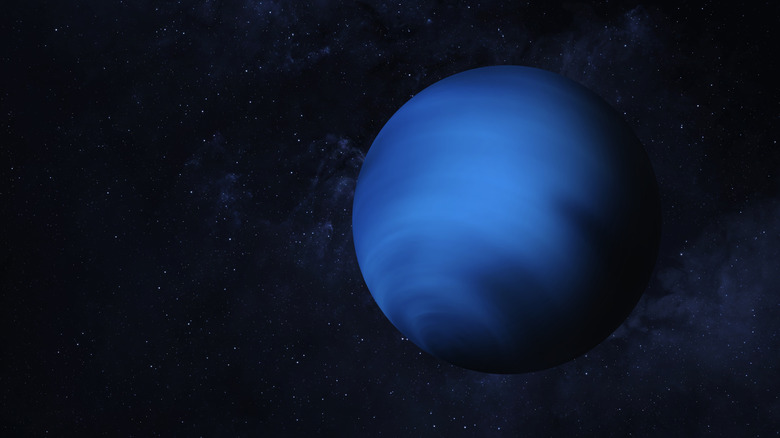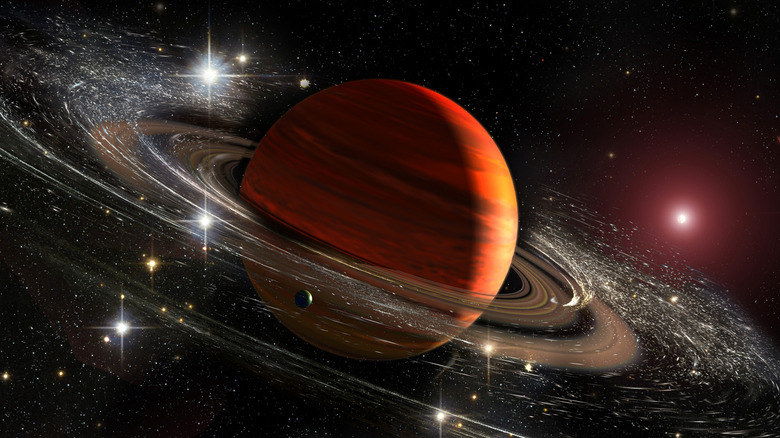11 Mysteries About Planets In Our Solar System That Went Unsolved For Years
Space is a very big place, and as such, it's full of mysteries that scientists can't explain. Some of this is simply because it's impossible to fully observe, thanks to its sheer size and the limitations of physics. After all, it's really hard to hazard a guess about the conditions of the Andromeda galaxy today, since the light we see from there right now is roughly 2.5 million years old ... and that's the galaxy closest to us.
Still, humanity is tenacious, and we've managed to witness some pretty amazing miracles in the parts of space we've been able to keep tabs on. Scientists have observed the biggest structure in the known universe, and discovered a strange interstellar space boundary. They've also managed to crack numerous previously unsolvable conundrums in our very own solar system. Let's take a look at some of the biggest secrets about the planets in our solar system that we've managed to figure out.
AI debunks a long-standing Mars mystery
The colonization of Mars has gone from a sci-fi concept to a prospect that NASA is seriously looking into, with an intention to potentially send astronauts to visit the red planet in the 2030s. This next step of the space race also involves billionaire Elon Musk's SpaceX company, which aspires to set up a vast Mars colony. Since the planet is a hotter piece of cosmic real estate than it's ever been, there's a keen interest to find if Mars has water, which would obviously help the colonization process greatly.
In 2025, researchers at the University of Bern and Brown University decided to use artificial intelligence to look into one of the most encouraging signs about water on Mars: several mysterious streak formations on the planet's Olympus Mons region. Patterns like these were first discovered by NASA's Viking project in the 1970s. They're present in several parts of Mars, and their constantly evolving look has caused scientists to theorize that they might be watercourses created by H2O that's salty enough to flow on the planet.
Unfortunately, the results of the study indicate that briny water doesn't have anything to do with the streaks. After the researchers fed a massive amount of data and images from various agencies' eyes on Mars to a machine learning algorithm, analysis of the streaks' changing patterns indicated that they're most likely the result of wind and other environmental factors moving the dust around.
One plucky probe uncovered Mercury's mysteries
Many aspects of Mercury are still a complete mystery to science. Thanks to its sheer vicinity to the sun, the planet is absurdly hard to reach and observe to this very day.
Sure, humanity has known about Mercury for at least 5,000 years, since there are records about the ancient Sumerian civilization being aware of the first planet from the sun. Despite this, we haven't really known many details about it until we quite literally crashed a probe on it. In 2004, NASA's Messenger (Mercury Surface, Space Environment, Geochemistry and Ranging) mission launched a probe that orbited Mercury from 2011 to 2015, at which point it quit the job rather dramatically and crashed on the planet. During this time, it was able to record and transmit information that shed light on many aspects of the planet that have mystified researchers since the 1970s, when the Mariner 10 probe performed the first Mercury flyby.
Scientists already knew that Mercury, like all other planets, is slowly cooling, but the Messenger data revealed that it does so at a comparatively fast-paced rate and that the cooling process has shrank the planet's diameter by some 8.5 miles over its lifespan. We also now know that Mercury has its own, skewy magnetic field, and that the planet's strange patchwork surface is a combination of "newer" surface terrain and older parts of the planet's center that have been pushed to the surface.
Scientists find water on Mars
Interestingly enough, that earlier Mars entry doesn't mean that there's absolutely no water on Mars. In fact, a group of geophysicists who analyzed data from NASA's InSight lander have found evidence that the planet might have an abundance of H2O.
The InSight mission lasted from 2018 to 2022 and focused on studying the depths of the planet, including its tectonic activity and structural makeup. InSight also found signs of water deep within the planet — enough of it to bury the entire surface under a planet-wide, mile-deep ocean. The evident existence of this gargantuan body of water up to 13 miles under the planet's surface suggests that Mars didn't simply lose all its water when its surface went dry some 3 billion years ago.
From a habitability standpoint, such depths unfortunately mean that the reservoir is virtually unreachable for prospective settlers. While that might be disappointing, it's worth noting that the water discovery has plenty of potential to one day answer another interesting scientific question: Whether there's life on Mars. "Establishing that there is a big reservoir of liquid water provides some window into what the climate was like or could be like," Professor Michael Manga of the University of California, Berkeley told BBC. "And water is necessary for life as we know it. I don't see why [the underground reservoir] is not a habitable environment."
Data from Voyager 2 solves long-standing Uranus mysteries
Voyager 2 is one of the great success stories of space exploration and an ongoing treasure trove of information about Saturn, Jupiter, Uranus, and Neptune — all of which it has flown by and observed.
Speaking of Uranus, the 1986 Voyager 2 flyby introduced numerous mysteries about the icy planet's atmosphere, such as a distinct lack of plasma and wild radiation belts with no apparent energy source. This made it seem like the planet's protective magnetosphere was all out of sync, which puzzled scientists for decades until the same data that introduced the mysteries ultimately provided a solution. In 2024, a new examination of the 1986 data revealed that the timing of the Voyager 2 flyby simply happened to be incredibly bad. Just ahead of the probe's visit, a powerful solar wind had hit the planet and briely thrown its magnetosphere in disarray, leading to skewed data.
Dr. Linda Spilker of the NASA Jet Propulsion Laboratory was one of the scientists analyzing the 1986 data, and as she told the NASA website, she was happy to see the explanations that the 2024 data-mining managed to dig up. "The flyby was packed with surprises, and we were searching for an explanation of its unusual behavior," she said. "The magnetosphere Voyager 2 measured was only a snapshot in time. This new work explains some of the apparent contradictions, and it will change our view of Uranus once again."
Scientists finally figure out Jupiter's pulsating aurora phenomenon
Even on Earth, auroras are an impressive sight that tourists flock to Nordic countries like Finland to witness. The phenomenon takes place when solar winds carry particles released by the sun's electromagnetic activity into Earth's atmosphere. There, they collide with nitrogen and oxygen atoms, releasing energy that makes the atoms glow with pretty colors. It may sound tricky, but the science is simple enough ... at least, on Earth. Other planets in our solar system have auroras, too, and Jupiter's are particularly complex and tricky to understand.
Jupiter's poles have peculiar, pulsating auroras that feature strong X-ray emissions. They occur often and are far more powerful than their cousins on Earth. They can be different on the North and South pole, and generally go against the common knowledge of how auroras function ... not least because science couldn't figure out the mechanic behind these X-ray pulses.
In 2021 — four decades after they were first spotted — a study was finally able to figure out the way Jupiter's X-ray auroras work by combining data from NASA's Jupiter exploration craft, Juno, and the European Space Agency's space telescope XMM-Newton. As it turns out, an interaction between solar winds and changes in the planet's magnetic field create a curved, electromagnetic ion cyclotron wave, which guides the charged ions to the planet's atmosphere in the polar regions. The impact of their speedy arrival creates a burst of x-rays that, in turn, makes up the aurora.
Jupiter's geometric storms can likely be solved by a 19th-century scientific experiment
Jupiter's most famous storm is its Great Red Spot, a massive anticyclone that is as mysterious as it is large. However, it's not the only strange thing happening on the planet's surface.
One of the more recent mysteries on this list are Jupiter's geometric cluster storms, which were found in 2019 courtesy of NASA's Juno mission. The planet's poles are surrounded by large cyclones that can be up to 4,350 miles in diameter, but the really interesting thing about them isn't their size — it's that they interact. The cyclones, which can last for months, often seem to form various geometric patterns that pack them close together.
A major mystery, potentially. Yet, it turns out that science may already have solved the dilemma of the geometric cyclones ... in the 19th century. According to Juno mission team member and Caltech professor Andrew Ingersoll and his fellow researchers, Jupiter's geometric storms bear a striking similarity to a 1878 experiment conducted by physicist Alfred Mayer, who found that magnets floating in water configure themself in geometrical patterns. Mathematical physicist Lord Kelvin turned this into a mathematical model, and in 2020, the experiment became an important building block in solving one of Jupiter's mysteries. Granted, the theory isn't 100% confirmed, and we still don't know all the secrets behind the geometrical storms, but at least we now have a decent idea of why they might like synchronized dancing.
NASA figures out the secrets of Jupiter's volcanic moon
For a long time, one of Jupiter's satellites was one of the most mysterious celestial objects in the solar system. Jupiter's moon Io is a scarred, scalding place with a surface that's full of hundreds of volcanoes. Io's volcanic activity is off the charts ... and for decades, we had absolutely no idea how it functions. Is a giant hidden reservoir of magma feeding the scores of volcanoes on the surface? Is Io pock-marked by a case of planetary acne, with every volcano's bursts fueled by its own underlying pool of magma?
Linda Morabito of NASA's Jet Propulsion-Laboratory discovered Io's volcanic turmoil all the way back in 1979, but it took until the Juno fly-bys of 2023 and 2024 for us to truly understand the reasons behind it. The secret is dramatic, to say the least; Io travels around Jupiter in a tight, elliptical cycle that takes just 42.5 hours. This causes the gas giant's gravitational pull to constantly squeeze the moon and release the proverbial grip.
Such force generates massive amounts of heat, which in turn literally melts parts of the planet and keeps its volcanic activity going, with each volcano indeed having its own magma reservoir. It's actually pretty surprising that Io has managed to avoid the "sea of magma under the surface" scenario despite the forces involved, and researchers are eager to apply this discovery to their studies of other celestial bodies.
The waters of Venus may have evaporated into space
Scientists have long suspected that Venus, like Earth, once had water. At some point, something happened, turning it into the hot and hellish planet it is today ... but what?
In 2024, a study posited a convincing (and horrifying) sequence of events that could have rendered the second planet from the sun to its current state. According to it, the large bodies of water that Venus may have had at some point fell victim to a truly terrible version of the greenhouse effect — the phenomenon where various greenhouse gases (such as carbon dioxide) of the atmosphere trap heat near the planet's surface, warming it dramatically.
On Earth, the natural version of the greenhouse effect is a life-sustaining force that maintains a comfortable surface temperature, but greenhouse gas emissions caused by humanity have thrown the process out of sync and led to rising surface temperatures. Venus, according to the study, may have experienced a far more extreme variety of this: Over time, the atmosphere's carbon dioxide levels rose to absurdly high levels, heating the planet until all the water simply evaporated. The evaporated water reacted with HCO+ ions in a reaction called HCO+ dissociative recombination, which broke the evaporated water molecules, built them again as carbon monoxide and hydrogen, and finally threw the hydrogen atoms out of the atmosphere at a high speed. This would have removed a crucial building block of water, thus stripping the planet of its H2O.
Saturn's Earth-sized white spot storms are likely kept in check by moisture
We've already mentioned Jupiter's Great Red Spot, which is without doubt the most powerful player in the solar system's planetary storm game. However, it's not the only participant in the supersized storm category.
Saturn experiences periodic "white spot" storms that are roughly the size of Earth (but can stretch quite a bit), occur roughly every 20 or 30 years, and can last for months. Researchers found them in 1876, and they immediately entered the mystery category because no one could figure out why they take actual decades to develop.
In 2015, researchers discovered that the most likely "control system" behind the white spot storms is one that's very familiar to us Earthlings: water. Most of Saturn consists of light helium and hydrogen, so the heavier moisture hangs out lower than them in the gas giant's atmosphere. This moisture layer, researchers think, serves as a sort of filter that prevents warm gas from freely rising up in the convenction process that's crucial in the atmospheric movements that lead into a storm. Without the moisture, the planet's gases could move more freely, and storms would develop more easily.
The very existence of Neptune as a planet was solved with math 200 years after its discovery
There are many planetary secrets that we've managed to solve with careful application of scientific tools and knowledge. However, Neptune is the only planet in our solar system that was discovered with the power of good, old mathematics.
After Pluto got demoted to dwarf planet status in 2006, Neptune inherited the title of the solar system's most faraway planet. Unlike its seven siblings, it can't be seen without special equipment, and its location and 165-year orbit can make it so deceptively stationary that early astronomers mistook it for a star. That's how astronomer and mathematician Galileo Galilei classified Neptune in 1612 and 1613, and that's how it remained (as far as humanity was concerned) until 1846.
Neptune's "origin story" as a planet came when scientists started noticing that Uranus — which itself had been discovered in 1781 — had an inconsistent orbit around the sun. Suspecting that other forces were in play, mathematician Urbain Joseph Le Verrier calculated the size and location of an unknown celestial object that could affect Uranus' path. After Johann Gottfried Galle at the Berlin Observatory received the calculations from Le Verrier, he almost immediately found the eighth planet from the sun.
Saturn's rings may have been formed when the planet's gravitational pull tore a moon apart
Saturn isn't the biggest planet in our solar system, but its impressive rings certainly earn it a place in the conversation for the prettiest one. Perhaps understandably, said rings are also the most enticing mystery Saturn has to offer. These seven rings around the gas planet have remained an enigma for hundreds of years, even though their makeup is no more mysterious than countless, different-sized pieces of rock and ice that just happen to orbit the planet in an aesthetically pleasing formation.
Some scientists believe that the rings are an assortment of comets and other small, passing celestial objects that Saturn's gravity had caught and broken down at some point between 100 and 400 million years ago. Some have also suggested that the rings could be roughly as old as the planet itself — 4.5 billion years.However, a 2022 study provided another, extremely interesting explanation which — unlike other theories about the rings — would also explain the peculiarities of Saturn's relatively large axial tilt.
By analyzing gravitational data from NASA's Cassini spacecraft, a MIT team determined that Saturn's rings are "just" 100 to 200 million years old, and are actually comprised of a bygone moon that got broken into tiny pieces when it ended up too close to the planet's pull. Such an event could also be responsible for throwing Saturn's tilt slightly out of sync with Neptune.

